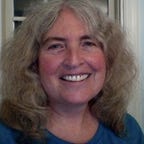A Special Library During This Era of Banned LGBTQ Books
I’m more grateful than ever to the library that guided me through a rough patch in college.
In the spring of 2014, I stood at my college reunion, in a courtyard surrounded by brick buildings, under a gigantic tent shielding us from the pounding rain. A friend asked how I’d describe my quintessential experience as an undergrad. Intense adolescent relationships that evolved into lifelong friendships? An education founded on insatiable curiosity? Professors whose lectures moved me to tears? All true. But for me, more than any one of those, Beinecke Rare Book and Manuscript Library captured the essence of my four years at Yale.
I wandered into Beinecke as the weather turned cold, unhinged by my first set of midterms. The wind chill was sharp for a Californian and I hurried along Wall Street, avoiding the more populated College Street. I didn’t want to run into my friends, or return to my dorm to face my roommates. I didn’t know how to tell them that I’d just proven myself to be unfit for college. I needed a quiet place to regroup before I packed my bags.
Hiding behind my scarf, I glanced to the right and found myself facing an odd structure, strangely beautiful. I had passed by several times, but this time I stopped. Without knowing why, I found myself walking in.
To this day, I’ve never seen a library more compelling than Beinecke. The walls are white marble squares — thick, strong, bizarrely translucent. The level of humidity, the placement of the sun and the density of the clouds all work together, guiding the light through the marble. The walls provide more than structure; they’re a canvas, always quivering, shifting, alive. Grays, browns, and whites interweave with hints of yellows and pinks, a spectrum both limited and infinite. Shapes created by the light chase each other through the marble blocks, changing as a breeze repositions a cloud, a ray of sun gives way to a shadow — designs born of the unpredictable.
The center of the library is a gigantic pillar encased in clear glass, holding several levels of rare books and manuscripts. Words, photographs, drawings. Written history. Yours, mine, ours. Inspiring, riveting, oddly comforting. As I shrugged out of my coat and emerged from my scarf, I didn’t realize I had stepped into my next college experience.
The area surrounding the pillar is open to the public and holds several glass cases, each holding rare books or manuscripts. On that reunion weekend, decades after my first set of monster midterms, I was greeted by two Gutenberg Bibles. I then moved on to Beatrix Potter, Alice In Wonderland, and maps of the “100 Aker Wood” from The World Of Pooh. I admired manuscripts from San Francisco and Marseilles, and smiled in surprise at a case of pages covered in startlingly bright silk, crimson and royal blue.
I turned from the exhibits and faced the pillar. I thought about the treasures hidden within its core, some famous and others obscure. Today as I navigate my country’s era of banned books, I’m thinking that somewhere in those levels of shelves and drawers lay Beinecke’s collection of forbidden books and manuscripts. I wonder where Gertrude Stein’s and Alice B. Toklas’s words rest, safe and protected. I imagine Larry Kramer on paper, lounging in the pillar, ready to surge into the light. I think of Toni Morrison’s Beloved and The Bluest Eye, which took my hand and led me into perspectives both painful and soaring — of Angie Thomas’s The Hate U Give, which helped me understand simultaneously the limitations and possibilities of my white perspective on racism — of Judy Blume’s Forever which I pored over as an adolescent discovering sexuality — of James Joyce’s Ulysses which I’m still trying to understand.
This weird and wonderful place captures the heart of my college experience, a time of compatible juxtapositions. Clunky blocks of impenetrable rock with light effortlessly flowing through. A Gutenberg Bible companionably next to Peter Rabbit. A time of learning how much I knew and how much I’d never understand, of limitation and possibility. Serious and playful. Respectful and lighthearted. Reverent and fun. Beinecke makes no sense whatsoever, and somehow reinstates meaning and truth.
Beinecke and I had met decades before that reunion, during a personal low point. Crushed and demoralized, I wondered if my college career would end with those first exams. But it didn’t. I swallowed my pride and confessed my midterm grades to a friend who had done well. In the kindest way, she read my exams and helped me figure out how to take a test. I gathered my courage and spoke to a professor whose exam I had torpedoed. Calm and sympathetic, she suggested I write the optional term paper to salvage my grade. To my utter astonishment, I discovered I loved writing papers.
Over time, I stopped worrying that I was the most pathetic specimen ever to be admitted. I learned and struggled and learned more. Somewhere along the way, I forgot to be afraid when I struggled. I had fun. I returned to Beinecke multiple times during those four years, through ups and downs, calms and storms, disappointments and triumphs.
Like the light, the exhibits at Beinecke continually change. I don’t remember the details of the display when I first entered at age eighteen. I don’t remember the precise palette of light on the walls that day. I do remember my amazement. Even more, I remember that as I journeyed around the displays, my curiosity returned and with it, confidence followed by perspective. Beinecke and I were instant friends, our bond established from our first meeting. Yale and I had a different sort of connection. We were a new relationship and we were off to a rocky start. But we had four years to work it out.
And we did.
